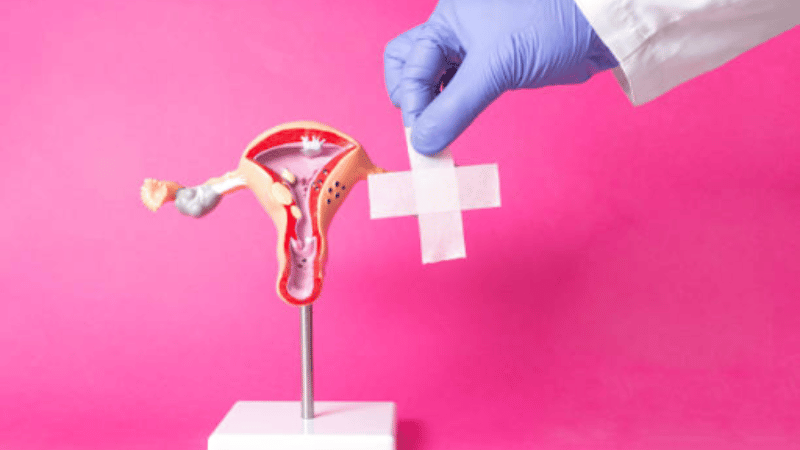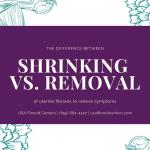
While ‘fast’ doesn’t mean immediate shrinkage, certain treatments can provide relatively quick symptom relief. Shrinking fibroids, or reducing their size, is a gradual process.
Uterine fibroid embolization (UFE) is a highly effective procedure that targets the blood vessels feeding the fibroid tissue. By blocking these vessels, UFE causes the fibroid to shrink, die off, and eventually be reabsorbed by the body.
Many patients experience significant improvement in symptoms such as heavy bleeding, cramping, and bloating within two to three weeks. Over the course of the next six months, the fibroids continue to shrink, and symptoms further improve, offering lasting relief.
USA Fibroid Centers’ expert fibroid specialists can help treat painful fibroid symptoms that interfere with daily life.
Learn More About Shrinking Fibroids
How To Shrink Fibroids
The fastest way to shrink uterine fibroids for symptom management depends on various factors, including the fibroids’ size, number, location, symptoms, and personal health goals. There are several fibroid treatment options available with varying recovery times, benefits, and overall effectiveness.
Minimally Invasive Procedures
The most effective treatments for faster fibroid shrinking are minimally invasive options that treat the fibroids without surgery, offer shorter recovery times, and lower risks.
Uterine Fibroid Embolization (UFE)
Uterine fibroid embolization is one of the fastest and most effective treatments for shrinking fibroids.
Uterine fibroid embolization, also known as uterine artery embolization (UAE), cuts off the fibroid’s blood supply so that it shrinks and dies. The procedure begins with fibroid mapping using advanced ultrasound to locate the fibroids. A thin catheter is inserted in the wrist or groin and then guided into the artery supplying the fibroids. Small particles, called embolic agents, are released through the catheter to block blood flow to the fibroids, initiating the shrinkage process. Performed under light sedation, UFE is typically completed in less than an hour and requires no general anesthesia. Patients can go home the same day with just a small bandage.
While UFE provides significant symptom relief within weeks, the full effects of fibroid shrinkage may take a few months to become evident. Recovery is generally rapid, with most women resuming normal activities within two weeks. Additionally, the injected particles, made up of plastic or gelatin and about the size of sand grains used in UFE, remain at the site, making it unlikely for fibroids to return to the treated areas.
Transcervical Radiofrequency Ablation
Other minimally invasive procedures to treat fibroids include transcervical radiofrequency ablation, which uses heat to target and destroy fibroid tissue.
Medications and Hormonal Therapies
Hormonal therapies and medications offer varying degrees of relief depending on the treatment.
Gonadotropin-Releasing Hormone (GnRH) Agonists
One type of treatment is gonadotropin-releasing hormone (GnRH) agonists, which block the production of estrogen and progesterone, placing the body in a temporary menopause-like state. This approach can shrink fibroid tumors fast, stop menstrual periods, and improve symptoms like anemia.
Progestin-Releasing Intrauterine Devices (IUDs)
Similarly, progestin-releasing intrauterine devices (IUDs) can help manage heavy bleeding caused by fibroids, though they do not shrink the fibroids themselves.
While these hormonal treatments can provide rapid results, they have significant side effects such as hot flashes, mood swings, and reduced bone mineral density. These medications only provide temporary relief, so the fibroids may regrow once treatment ends.
Surgical Options
Surgical procedures are often recommended for managing large or multiple fibroids. Since these surgeries involve the complete removal of the fibroids at one time, they can be considered the fastest way to remove uterine fibroids. Two of the most common surgeries are myomectomy and hysterectomy.
Myomectomy
A myomectomy removes fibroids while preserving the uterus. While effective, myomectomies carry risks such as excessive bleeding, infection, blood clots, and anesthesia reactions. Recovery from a myomectomy can take four to six weeks or longer, depending on the number and location of fibroids removed. The procedure can also cause potential complications in pregnancy and childbirth.
Hysterectomy
A hysterectomy is the removal of the uterus, and depending on whether it is a total or partial hysterectomy, it can also involve removing the cervix and ovaries. This process typically triggers immediate menopause for premenopausal women, causing hot flashes, insomnia, and mood swings. Hysterectomies also eliminate the possibility of future pregnancies, with a typical recovery time of six to eight weeks.
Unlike minimally invasive treatments that aim to shrink fibroids over time, surgical procedures like myomectomy and hysterectomy provide immediate removal but involve more extended recovery periods and more significant risks and long-term effects.
Choosing the Right Fibroid Shrinking Treatment for You
Choosing a fibroid treatment means considering the severity of your symptoms, the size and number of fibroids, your overall health, and your personal goals, such as preserving fertility. Fibroids can grow quickly and suddenly, making preventative treatment even more critical.
Consulting a fibroid specialist is important for exploring options and making an informed decision about fibroid treatment. At USA Fibroid Centers, we offer screenings to diagnose fibroids and work with you to develop a personalized treatment plan.
Benefits of UFE for Fast Fibroid Shrinking
Uterine fibroid embolization (UFE) offers numerous benefits for those seeking fast treatments for fibroid shrinking to minimize symptoms. This minimally invasive procedure requires no uterine incisions, resulting in less pain and a short recovery time.
The American College of Obstetrics and Gynecology (ACOG) considers UFE safe and effective for treating fibroids while preserving fertility. The procedure is highly effective at alleviating fibroid-related symptoms such as pain, heavy bleeding, and pressure, with most patients recovering within one to two weeks. Performed in an outpatient clinic with a low risk of complications, UFE is often covered by insurance. Flexible payment plans are also available with USA Fibroid Centers. Our online scheduling tool is free and can help you instantly verify your insurance coverage.
Verify Your Insurance Coverage for UFE
Finding the Best and Fastest Solution
Finding the best and fastest way to shrink uterine fibroids depends on your unique circumstances. For many women, UFE offers a fast and effective path to relief with minimal recovery time.
USA Fibroid Centers’ interventional radiologists specialize in personalized care to help you determine the best treatment option for your needs. Schedule a consultation online or call 855.615.2555 for relief from fibroid symptoms.
FAQS about How to Quickly Shrink Fibroids
What can shrink fibroids fast?
It is possible to temporarily manage fibroids through Gonadotropin-releasing hormone (GnRH) agonists like Lupron or medication. For longer-lasting solutions, the best options are surgery or minimally invasive treatments like uterine fibroid embolization (UFE).
When choosing the best treatment for your fibroid symptoms, discussing concerns and questions with a fibroid specialist is important.USA Fibroid Centers has a team of highly experienced interventional radiologists who diagnose fibroids and discuss the best treatments for you.
How long does it take a fibroid to shrink?
The time it takes for fibroids to shrink depends on the type of treatment and severity of the condition. With non-surgical treatment options such as uterine fibroid embolization (UFE), fibroids typically begin shrinking within two to three months. They may continue to shrink for six to nine months or longer. Results depend on the fibroids’ number, size, and location. Some individuals may notice symptom relief as early as their next menstrual cycle, while others may take longer.
What can make a fibroid shrink faster?
Medications and stress management, such as meditation and yoga, may help regulate hormone levels and briefly relieve minor symptoms. However, for the most effective treatment and fastest symptom relief, nonsurgical options like uterine fibroid embolization (UFE) are recommended.
Consult one of our fibroid specialists from USA Fibroid Centers today to determine the best treatment for your symptoms.






